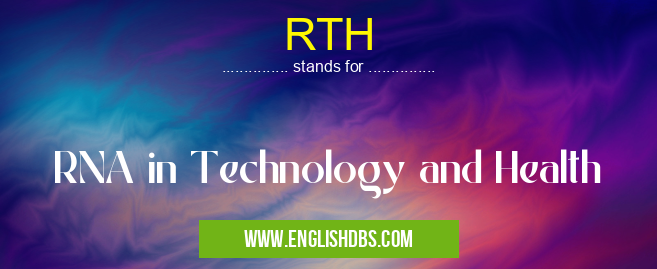What does RTH mean in HEALTHCARE
1. Diagnostics and Therapeutics:

RTH meaning in Healthcare in Medical
RTH mostly used in an acronym Healthcare in Category Medical that means RNA in Technology and Health
Shorthand: RTH,
Full Form: RNA in Technology and Health
For more information of "RNA in Technology and Health", see the section below.
» Medical » Healthcare
Applications of RTH
- RNA-based diagnostics: Developing tests that detect specific RNA molecules associated with diseases.
- RNA interference (RNAi): Using small RNA molecules to silence specific genes, potentially treating genetic disorders.
- RNA vaccines: Utilizing RNA to deliver genetic material and stimulate immune responses, protecting against infections.
2. Materials and Technology:
- RNA nanotechnology: Engineering RNA molecules to create functional materials with unique properties.
- RNA-based bioelectronics: Developing RNA sensors and devices for medical diagnostics and environmental monitoring.
- Synthetic biology: Using RNA to design and build biological systems with specific functions.
Essential Questions and Answers on RNA in Technology and Health in "MEDICAL»HEALTHCARE"
What is RNA in Technology and Health (RTH)?
RTH is an emerging field that harnesses the power of RNA for innovative applications in both technology and healthcare. It involves utilizing RNA's unique properties to develop novel technologies and therapeutic strategies.
What are the key advantages of using RNA in technology?
RNA offers several advantages in technology due to its:
- Versatility: RNA can be engineered to perform various functions, including gene regulation, protein synthesis, and sensing.
- High specificity: RNA can target specific genes or proteins with precision, making it a valuable tool for gene editing and targeted therapies.
- Biocompatibility: RNA is naturally occurring in living organisms, reducing the risk of immune reactions or toxicity.
How is RNA used in healthcare?
RTH has significant potential in healthcare, including:
- mRNA vaccines: RNA-based vaccines deliver genetic instructions to cells, triggering an immune response against specific pathogens.
- Gene editing: RNA-based techniques, such as CRISPR-Cas9, allow precise modification of genes, opening up possibilities for treating genetic disorders.
- RNA interference (RNAi): RNA molecules can silence specific genes, offering a targeted approach for suppressing disease-causing proteins.
What are the limitations of RNA in technology and health?
Some limitations of RNA include:
- Instability: RNA is susceptible to degradation by enzymes, limiting its stability in biological environments.
- Delivery challenges: Delivering RNA into cells efficiently remains a challenge, particularly for in vivo applications.
- Off-target effects: RNA-based technologies may inadvertently target unintended genes or proteins, leading to unwanted side effects.
What are the future prospects for RTH?
RTH is a rapidly evolving field with immense potential for breakthroughs in technology and healthcare. Ongoing research focuses on advancing RNA delivery methods, improving stability, and exploring novel RNA-based applications. As these challenges are overcome, RTH is expected to make significant contributions to advancements in gene editing, personalized medicine, and beyond.
Final Words: RTH is a rapidly growing field that holds immense potential for revolutionizing healthcare and biotechnology. By harnessing the power of RNA, researchers and scientists are developing innovative approaches to diagnose and treat diseases, create new materials, and advance scientific knowledge. As research in this area continues, we can expect further advancements and discoveries that will shape the future of medicine and technology.
